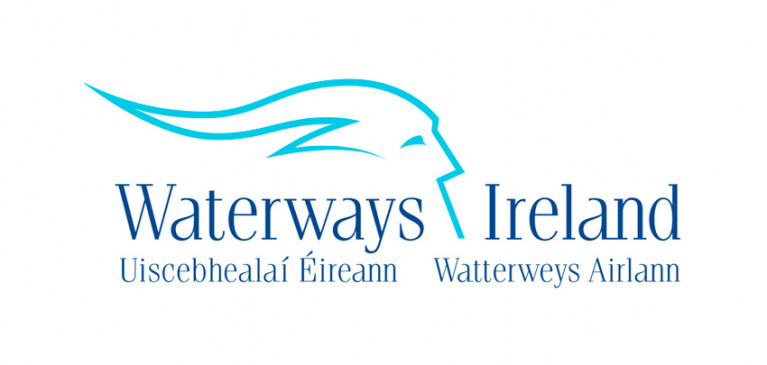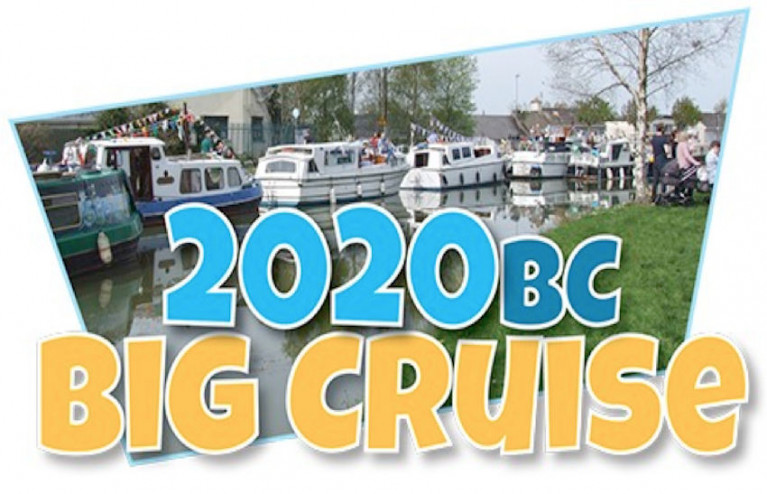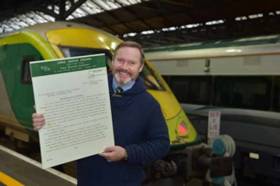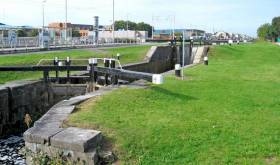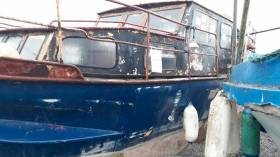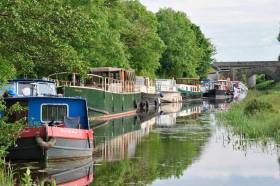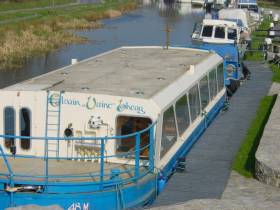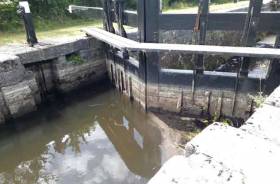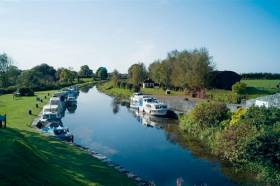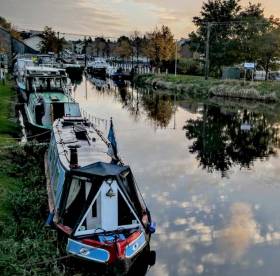Displaying items by tag: Grand Canal
Reduced Water Levels On Grand Canal Naas Branch
Waterways Ireland advises users of the Grand Canal that water levels will be reduced in the Sallins area (Level 15 from Killeen Golf Club to Digby Bridge) over the coming weeks.
This in order to facilitate lock gate replacement works at Lock N1 on the Naas Line in Co Kildare.
Works on the waterway began on Tuesday 21 January and will be in progress until to Wednesday 1 April.
New Year’s Day Flotilla To Launch 2020 Big Cruise Calendar For ‘Green & Silver’ Inland Navigations
The Inland Waterways Association of Ireland (IWAI) is ringing in the New Year with the launch of its 2020 Big Cruise calendar of events on the inland waterways of the Green & Silver route.
A flotilla of light and fast boats set off at pace on the River Liffey from the sea lock at Grand Canal Dock to Seán Heuston Bridge below Heuston Station this lunchtime (Wednesday 1 January) to kick off the 2020BC initiative.
The date also marks the 60th anniversary to the day the Grand Canal was closed to commercial traffic by CIÉ.
2020BC will centre around a calendar of waterside community celebrations and events to which boaters and other waterway users can travel next year.
This reflects the navigation circuit being very much ‘open for business’ for leisure, pleasure and amenity use.
The 2020BC project is being co-ordinated for IWAI Dublin by longtime waterways advocate Mick Kinahan with support from IWAI’s Kildare, Offaly, Shannon Harbour, Royal Canal and Barrow Branches.
Today’s flotilla also carries some offerings from the Grand Canal to Heuston Station — symbols from locations along the canal’s length, of both past and present commercial and leisure activities.
Little known outside the boating community, the Grand Canal is also part of what is known as the Green & Silver: a navigation route comprising the Royal Canal, Camlin River, River Shannon, Grand Canal and River Liffey — and one that the IWAI is keen to promote during 2020BC and beyond.
IWAI president Alan Kelly said: “We are fortunate in IWAI to have experienced volunteers who are fully committed to the promotion of our waterways for the common good and the socio-economic benefit of all.
“We also have an excellent working relationship with Waterways Ireland and with Government departments, local authorities, development associations and community organisations all along the inland waterways network.
“We look forward to 2020 being a year of further positive engagement with all of our waterways partners to promote the development and improvement of our waterways.”
Jim O’Riordan, IWAI Dublin chairperson, added: “IWAI Dublin look forward to 2020BC and are grateful for the support from our peer IWAI branches around the inland waterways network for the project.
“We also want to thank Waterways Ireland who have been involved in helping us plan today’s launch and events for the coming year; and Clontarf and Poolbeg yacht clubs among others who have assisted arrangements for the launch flotilla.
“For 2020BC, what we are promoting is not just about boating, we intend to work with as many communities as possible to develop their interests further in the inland waterways in their vicinities and look forward to meeting many new waterways friends.”
Full details of events for 2020BC will be made available on the IWAI website.
60 Years Since the Closure of the Grand Canal to Commercial Traffic
60 years ago, on 25th November 1959; a memo was issued by CIÉ to close the Grand Canal to commercial traffic, formally ending the era of barge trading boats use of the Irish inland navigation system.
But the Grand Canal is thankfully still a well-utilised navigation encouraging discovery and exploration while travelling from Dublin in Ireland’s Ancient East right through to Ireland’s Hidden Heartlands! From our indigenous canal boat tourists, who travel on their own vessels, to the novice or experienced hire boat tourists; the Grand Canal navigation is timeless.
It takes you all at once back to the heyday of trading boats in the early 1800s while also providing access to waterside communities all along its length, from Dublin to Shannon Harbour in West Offaly and to Athy in South Kildare.
Navigating this route by boat is a truly unique experience. Members of voluntary organisations such as the Inland Waterways Association of Ireland (IWAI) and the Heritage Boat Association (HBA) will always welcome you aboard.
All of this takes place alongside anglers, canoeists, walkers and cyclists who also appreciate the magic and beauty of the Grand Canal and its environs. Long silent of the horses’ hooves that provided momentum for Ireland’s then developing economy, canal towpaths and trackways have been re-imagined with the arrival of the Greenway concept for cycling and walking. In addition to boating, these activities have the potential to provide huge economic benefit to Grand Canal communities. The Grand Canal Greenway is being developed as part of a national cycling strategy in partnership with Waterways Ireland (WI), Local Authorities, government departments, local communities and development groups.
Approximately 1000km of inland waterways including the Grand Canal are managed by Waterways Ireland, the largest of six North/south Implementation Bodies established under the British Irish Agreement of April 1998.
IWAI are re-releasing this memo to honour the Grand Canal; all the boatmen and families who worked on her; the agencies, boating and canal side communities who continue to support her; and to highlight this rich vein of current and potential tourism value running from the capital city to the centre of the midlands.
CIÉ spokesperson Barry Kenny said ‘CIÉ were custodians of the Grand Canal for many years and while commercial navigation ceased 60 years ago, the stewardship of Waterways Ireland and support of Inland Waterways Association of Ireland ensures that its role as a leisure and tourism amenity continues to strengthen. The memo marked the end of a chapter, but the story of the Grand Canal continues, and we wish WI and IWAI the very best in the future.’
John Boyle, Director of Business Development, Waterways Ireland says ‘Waterways Ireland is proud of the heritage associated with the Grand Canal and indeed all of the inland navigable waterways. Whilst 1959 marked the end of commercial traffic on the Grand Canal, the experiences and stories of the canal up to that period are vitally important from an historical point of view in the growth of the Irish economy and the associated growth of local communities. It is those local communities who now provide an important role to play in the continuous re-imagining of the Grand Canal into the future to become the bedrock of history for the future. 1959 therefore was an important ‘watershed’ in time, linking the past to the present and into the future. We thank the IWAI, HBA and all those associated with remembering this date 60 years ago and look forward, whilst not forgetting the wonderful history of our past.’
Alan Kelly, President of the IWAI noted ‘The Inland Waterways Association of Ireland are delighted to present a copy of the memo issued by CIÉ on 25th November 1959 to Tony Doran, Station Master, Heuston Station, Dublin; to mark the 60th anniversary of the original memo release. We hope the re-release generates a lot of interest in this great inland waterway on the Irish navigation system, supported by relevant agencies and communities -much appreciated by the IWAI, the HBA and all those who enjoy the Grand Canal for sport, relaxation, nature appreciation and general wellbeing in both urban and rural environments’.
Grand Canal Drained Over Sewer Collapse In Dublin
RTÉ News reports that a lengthy section of the Grand Canal in Dublin has been drained after the partial collapse of a trunk sewer in the city.
The breach of the sewer system at Suir Road in Inchicore has had no impact on local homes or businesses, and the sewer is still in operation.
However, the emergency works have required the waterway to be closed and emptied between Locks 1 and 2 — with no timetable as yet for restoration of access from the main body of the canal to the city centre.
RTÉ News has more on the story HERE.
Waterways Ireland To Hold Sale Of Craft Removed From Grand Canal
Waterways Ireland intends to dispose, by public tender, of a number of vessels removed from the Grand Canal at Shannon Harbour, Tullamore, Barrow Navigation, Killaloe Canal and Shannon Bridge.
Twelve vessels are presently stored on the South Bank of the Grand Canal adjacent to the Transit Shed in Shannon Harbour. One vessel is stored in Fenniscourt on the Barrow Navigation and other vessels are stored in Ballyleague and Munster Harbour, Portumna.
All vessels may be inspected (externally only) by local arrangement. Tender and relevant documentation is available from the Assistant Inspector of Navigation at +353 87 286 5726 or [email protected]. Alternatively you can download the tender documentation from the Waterways Ireland website.
Sealed tenders should reach the Assistant Inspector of Navigation at the above address not later than noon on Monday 18 March.
A condition of sale is that vessels be removed from the canal property once purchased. Removal details will be notified to successful purchasers once transactions are finalised.
Online Applications For Mooring & Passage Canal Permits Now Open
#InlandWaters - Combined mooring and passage permits and extended mooring permits for the Grand Canal, Royal Canal and Barrow Navigation for the 2019 season are now available online from Waterways Ireland.
All permits will run until Thursday 31 October, with annual renewal on 1 November each year. Applications require a photo of the vessel and a copy of its insurance (third party minimum).
Applicants can decide to print their own permit or have a hard copy sent by post. Submitted applications will receive an acknowledgement email, and once approved, an online link will be emailed for payment.
Questions regarding the application process can be forwarded to the inspectorate at [email protected] or by phone to 09064 35690 (9am-12pm Monday to Friday).
#HistoricBoats - Waterways Ireland is seeking tenders to restore a legacy canal barge as an office space for Dublin’s Silicon Docks.
According to the tender document, Waterways Ireland intends to clean out the vessel, further inspect its structural condition and convert it into “an open plan office for 6 workers with galley, meeting room and WC”.
The vessel would be moored at Grand Canal Basin alongside other similar floating work spaces.
It will also be self-propelled to enable it to move to other locations within the inland waterways network, and as such a P2 passenger boat licence will be required.
The Heritage Boat Association has more details on the barge, which was extensively rebuilt in at Shannon Harbour in a community project from 1996 to 2003 and renamed Cluaine Uaine Bheag.
Originally built as a general motorised trade boat by Vickers for the Grand Canal Company in 1928, the barge – then known as 48M – would have carried Guinness and other cargo until the canal’s commercial closure in 1959.
Water Levels Low on Grand Canal System
Waterways Ireland has advised that due to the heat wave water levels on the Grand Canal system are low on many levels, particularly East of Tullamore in County Offaly.
The Inspector of Navigation, Patrick Harkin, says owners and masters of vessels navigating these areas should do so 'with caution'.
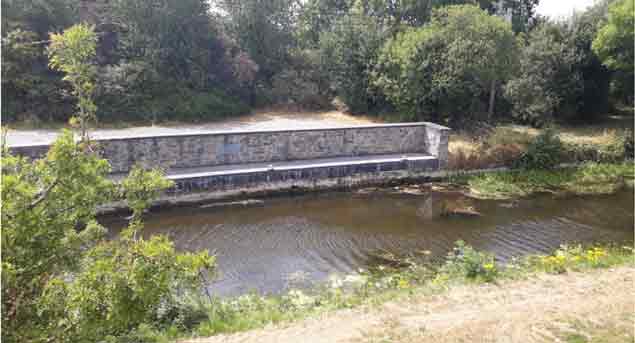 The harbour wall at Daingean Photo: Waterways Ireland
The harbour wall at Daingean Photo: Waterways Ireland
No Further Passage In 2017 On Grand & Royal Canals
#InlandWaters - Waterways Ireland wishes confirms that no further boat movements will be organised into or out from Dublin east of Lock 12 on the Grand and Royal Canals until the 2018 season.
The Grand Canal will shortly be closed for works in the Bluebell area in Dublin, and water levels will be reduced for the winter season.
Waterways Ireland apologies for any inconvenience this may cause its customers and thanks their customers for their understanding in this matter.
Celebrating the Grand Re-Opening: 30 Years of the Naas Canal
The Inland Waterways Association of Ireland (IWAI) Kildare will return again to Naas Harbour to celebrate the Naas Canal Festival which runs from Friday October 27th to Monday October 30th. This year’s Festival is a very special event as 2017 marks 30 years since the Naas Line of the Grand Canal was re-opened to boat traffic. In the early 1980s, a fledgling IWAI Kildare, supported by IWAI Dublin, highlighted the potential for tourism development of the Grand Canal in Naas. 30 years on and a large fleet of boats is expected to attend the Festival in Naas Harbour. On Friday 27th and Saturday 28th the travelling boats will be assisted through the locks by staff from Waterways Ireland, IWAI Kildare volunteers and members of the 23rd Kildare – Sallins – scouts, who are eager to put their lock operation training into practice. If you have never seen a lock being used or you have never seen a boat cruise the canal, this October weekend will not disappoint.
As well as the flotilla of vessels old and new, there will be a number of public events in the lead up to and during the Festival. A Waterways Exhibition will run in Naas Library from Monday October 23rd to Friday 27th featuring material from IWAI, the Heritage Boat Association and Waterways Ireland. There will be a variety of activities taking place on Sunday afternoon, October 29th, from 1pm to 5pm, including music from The Water Gypsies, Waterways Information Talks, an Exhibition by Sean Curran Art, boat trips on the canal by bargetrip.ie, the launch of a new children’s book by author Emma-Jane Leeson who will host readings from her book on a Barge. Of course, the boats themselves will also be on display and the boat owners will be on hand waiting to answer your questions or even give you a tour; don’t be shy about approaching them.
In the spirit of the founders of the IWAI, who established the Association in 1954 to campaign against the installation of fixed-span bridges across the River Shannon, IWAI Kildare will use the Naas Canal Festival to continue to showcase the leisure potential and historical significance of the Grand Canal in this area.
The Inland Waterways Association of Ireland (IWAI) is a voluntary body representing over two thousand enthusiasts, with 23 branches across the island of Ireland.
The Inland Waterways Association of Ireland (IWAI) is an energetic, fun, voluntary organisation with members from all corners of the Island of Ireland, all sharing a keen and passionate enthusiasm for the waterways of Ireland.
The IWAI advocates the navigation, use, maintenance, protection, restoration and improvement of the inland waterways of Ireland. It was formed in 1954 to promote the development, use and maintenance of Ireland's navigable rivers and canals.
IWAI Kildare was established in 1984. In the early years IWAI Kildare was assisted by IWAI Dublin to restore and enable the re-opening to navigation of the Naas Line of the Grand Canal main line. Currently, IWAI Kildare aims to promote the use of the waterways of Co. Kildare by running rallies throughout the county.
IWAI Kildare is actively campaigning to re-open the Corbally Line of the Grand Canal from Naas Harbour to Corbally Harbour. This stretch of waterway is in good condition but passage for boats is blocked by a number of culverted crossings, including the road from Naas to Newhall which crosses the canal near Jigginstown.


























